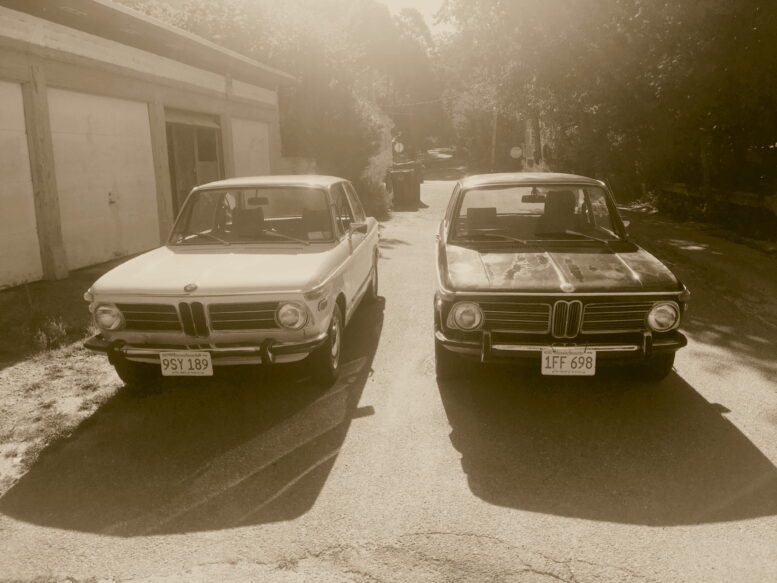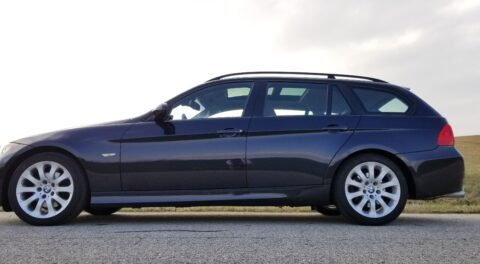Among the many ways I am blessed in this life, I own two round taillight 2002s. Louie is the Ran When Parked car—the ’72 2002tii I bought dead and sight-unseen in Louisville six years ago, drove down there in a rented SUV with tools and parts, resurrected it, and drove it home. Hampton is the 49,000-mile ’73 2002 I bought from its original owner in Bridgehampton Long Island four years ago.
The cars have certain similarities beyond their both being “roundie” 2002s. They’re both largely-original survivor cars. They both had been sitting for about a decade when I bought them. They’re both wearing original steel wheels and hubcaps, though the wheels on Louie were painted gray by some previous owner, and I leave them that way if for no other reason than because it bugs the crap out of Paul Wegweiser. And they both make me and others smile when I drive them. I’ve long said that one of the joys of owning a vintage car is simply errand-running in it, going to Trader Joe’s on a Sunday morning for milk or stopping at a yard sale and having people approach you and say, “I had one of those! I loved that car!” Both Louie and Hampton do this exceedingly well, as they both are the 2002 equivalent of the girl next door as opposed to a prom queen. They are both wonderfully approachable ambassadors of round-taillight goodwill.
There are, though, obvious differences between the two cars. Hampton is an essentially rust-free car, a remarkably intact survivor that looks like the 49,000-mile car that it is. It’s by no means dead mint, but it’s right pretty. The original Chamonix paint shines. The original navy interior is to die for, with original rugs, the original Blaupunkt with shiny chrome trim, the dashboard with a single tiny crack, and near-perfect intact chrome film on the trim pieces on the doors. When I bought Hampton, I thought, “What the hell am I ever going to do with a 49,000-mile car whose value is in its not being driven?” and viewed it as something to flip. When it didn’t sell on BaT two-and-a-half years ago, I was bummed and needed to put the car in storage while I thought about it, but over time I’ve completely come around and feel that the no-sale was a blessing and the car is likely to be with me for the long haul.

Hampton looking just right.
Louie looks a bit more knocked around by life. It has no small amount of patina and has rust appearing in more places than I’d like. A previous owner tried to address the carport-induced rust blisters with a grinder and whatever shade of rattle-can Rustoleum was closest to the car’s Agave paint (likely Hunter Green). The hood shows what appears to be delamination of the clear coat (wait… clear coat failure on ’72 Agave paint? I have no clue either.) along with some surface texture so rough that it seems to be welding spatter. The interior is original, but the rug is in poor shape, and all the interior chrome is corroded or pockmarked or both. All of this means that I don’t worry as much about the car, though its creeping rust means that I certainly don’t go out of my way to drive it in the rain.

Louie’s looks are a bit more challenging.
And, in an odd bit of symmetry, the two cars share a pair of seats—each has a Konig (Recaro-style) driver’s seat. The pair of Konigs originally came in Kugel, my departed Chamonix ’72 tii, and were eventually replaced with a mint set of E21 Recaros a guy gave me as payment for helping him sell his car. I installed one of the Konigs in Louie years back because its driver’s seat was badly split, and because I wanted the lumbar support on road trips. I put the other one in Hampton because I didn’t want its mint driver’s seat to suffer the same fate as the one in Louie, but it was also an admission that I was actually driving Hampton instead of hoarding it.

One of the Konig seats in Louie…

…and its twin in Hampton.
I had Hampton in the garage here at the house over last winter, but didn’t really do a lot of work on the car. It’s had a long-standing hard-starting issue that, whenever I think I’ve solved it, it rears its ugly head and laughs at me. This was over and above the standard hard-starting that carbureted cars often have when they sit for months and the float bowls dry up. I poked at the problem over the winter but was hesitant to say that this time I fixed it for good. In contrast, Louie, as a fuel-injected tii, has started dependably even after sitting for six months out in the Monson warehouse where I rent space on the Massachusetts-Connecticut border. In late May, I drove non-air-conditioned Hampton back to the Monson warehouse and swapped it for my ’79 Euro 635CSi which needed an a/c repair and recharge, then swapped the shark for air-conditioned Louie in July so I could have my summer 2002 experience in cool roundie comfort (my life is such a living hell).
Louie and Hampton may both be roundie 2002s, but from a running and driving standpoint, they’re very different cars. Louie is a tii, and even the bonding we achieved during the Ran When Parked adventure notwithstanding, I love tiis. I love the feel of the Kugelfischer mechanical fuel injection as it winds up. They really are significantly quicker than a stock carbureted 2002. Plus, Louie is not only a tii, but a ’72 tii with black plastic intake plenums, which means that it has the 121 head with its smaller combustion chambers outfitted with 46-mm intake valves (when BMW switched to the E12 head, all 2002s, both carbureted and injected, received the 46mm intake valves, but the ’72 tii is the only 2002 with a 121 head with 46mm intake valves instead of 44mm). Many folks, including me, feel that these ’72 tiis have a little more snap than the ’73s with the E12 head and its larger combustion chambers.
Although I was hesitant to muck with Louie’s suspension because the car felt exactly like a ’72 tii is supposed to feel, its shocks and struts were so tired as to be nearly non-functional (the struts were the original oil-filled dampers), so I went the Bilstein HD route. While I was in there, I chose to also replace the stock springs with H&R progressives, and the stock sway bars with Suspension Techniques, as this triad is the go-to combination many 02ers use to liven up a street car. This was a “budget refresh“—the springs were new but the Bilsteins and the sway bars were used parts.

New springs and used Bilsteins in the back…
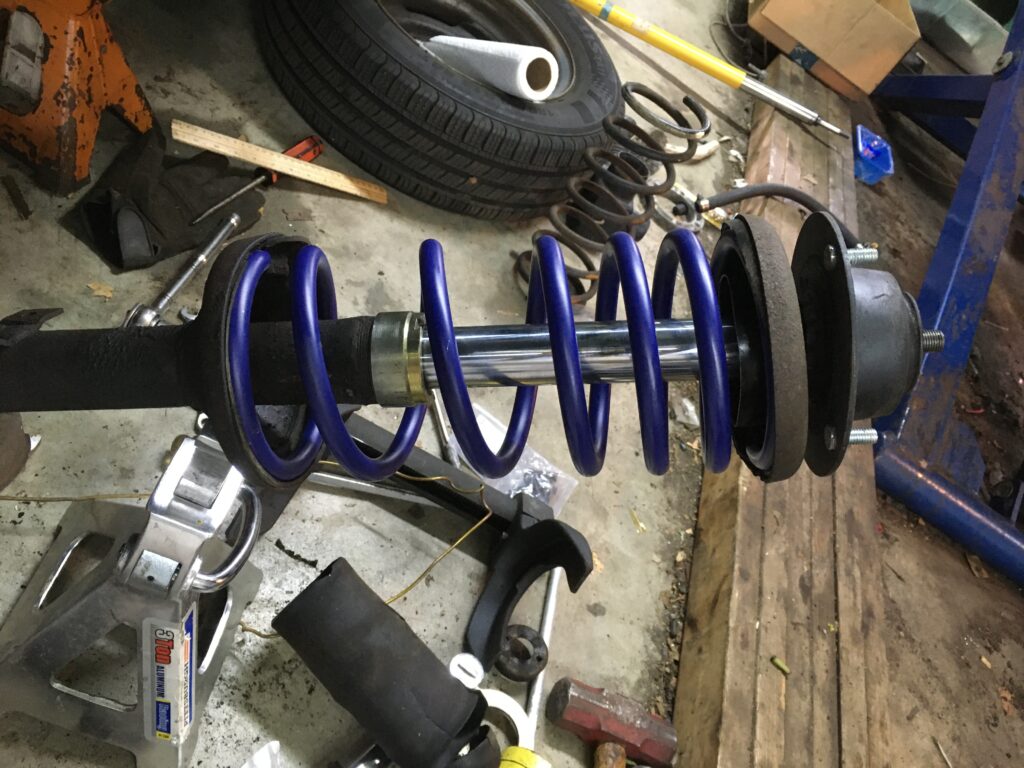
…and in the front.
I’m of two minds about the results of Louie’s suspension refresh. On the one hand, it definitely woke Louie up; the car now has much more snap to its handling. On the other hand, stiffening a suspension is a sure way to introduce new rattles, thunks, and clunks, and exacerbate existing ones. I wrote a few weeks ago about fixing Louie’s banging bumper, but the more I drive the car, the more I realize that the bumper fix was just addressing one of multiple layers of noises. I joke about the whole “it’s the bushings” thing (people automatically assuming that any thunk or clunk is due to subframe or suspension bushings), but it’s feeling more and more to me like the noise I’m hearing is from behind the doors, which I have to admit is circumstantially likely to be the subframe and/or the trailing arm bushings. Plus, the urethane bushings that clamp the Suspension Techniques sway bars to the subframe are known squeak-makers (well, it’s more like a grinch sound). On the highway it’s a delight, but on rough local roads, the combination of the grinch and the thunk is really getting on my nerves.
In addition, over the past few weeks, Louie has developed a hot-restarting problem. The car will fire up cold perfectly fine, but sometimes, if I need to restart it once it’s warmed up, it’ll just crank and crank and crank. I’ve had this issue on other tiis, and it’s generally been the cold start valve not firing (even when the engine is hot, it still may need a squirt), but I haven’t found anything wrong with it. I had a funny event last weekend when I was running an errand in Louie, stopped at a yard sale on the way home, the homeowners saw the car and knew what it was, we chatted for almost half an hour, and when I was ready to leave, I said “Watch, now it won’t start, and you can laugh at me,” and that’s exactly what happened (it did eventually fire up). While this was happening, I noticed that, when I relaxed the key back from “start” to “run,” the car almost idled. I thought “A-ha the coil isn’t getting current while cranking.” When I got home, I verified that I still had the hot-restart problem, then hot-wired the “15” terminal (also labeled “+”) directly to the battery, and the car started fairly easily. But when I checked with a multimeter, I didn’t see a no-voltage condition while cranking, so I’m not sure what the issue is. For now, I stashed a jumper wire with an alligator clip for the battery at one end and a spade connector for the coil on the other end in the cowl space next to the wiper motor.
I did a light suspension refresh in Hampton as well a few years back. Like Louie, Hampton was still wearing its original oil-filled “wet struts,” but unlike Louie where I also did springs and sway bars, Hampton’s refresh stopped at a used set of Bilstein HD shocks and struts.
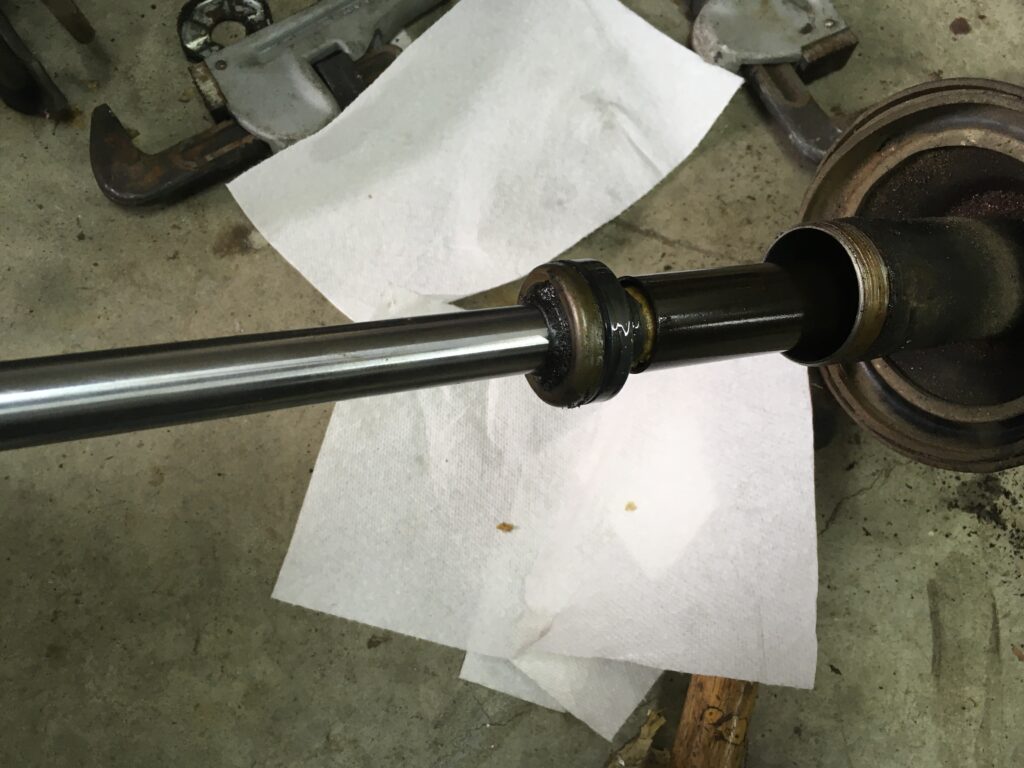
Out come Louie’s “wet struts.”

In go the Bilsteins.
Early this week on a flawless New England fall day, with the hot muggy weather behind us and the crack of fall firmly in the air, I decided to swap air-conditioned Louie for no-a/c-but-right-as-rain Hampton. The drive out to Monson on I-90 was a slice of heaven. I, the a/c fanatic who jokes “Don’t be an R75/2 guy (75 mph, 2 windows down)” did exactly that, and it was perfect.

Livin’ the dream. Okay, as pictured, it’s only R70/2. Busted.
Every time I talk about carbureted cars being hard to start after sitting, my good friend Mike Self emails me to remind me that I can take a syringe filled with gas and squirt it in the little opening on the forward edge of the Weber’s throat, as that leads directly to the float bowl. I keep meaning to try Mike’s technique, but this time, I did remember to take an electric fuel pump and temporarily splice it in place of the stock mechanical one to prime the system. This has the advantage of not only filling the float bowl, but priming the fuel lines all the back to the tank. The pump I use for this already has a long wire with a clamp crimped on that I attach directly to battery positive. Then I simply hold the black wire to any ground until I hear the rap-rap-rapping of the fuel pump change its sound as the gas encounters the closed needle valve in the float bowl and fills the fuel line. Bowls filled, lines primed, done.

Mike has his float-bowl filling trick. I have mine.
While I had my head in the engine compartment, I noticed that the smaller leg of the ground strap—the one that’s supposed to be attached to the body—was disconnected from the eyelet that’s supposed to ground it near the battery tray. I wondered how long this had been going on, and if it had anything to do with Hampton’s hard-starting problem. After all, without the chassis ground strap attached, all grounding has to occur through the ground strap to the engine, and the engine has its own ground strap precisely because the rubber engine mounts prevent it from being well-grounded otherwise. It’s fairly common on 50-year-old BMWs for these ground straps to corrode and break off at the attachment point. However, as you can see in the pic below, here it pulled out as opposed to broke off, so I should be able to re-crimp it.
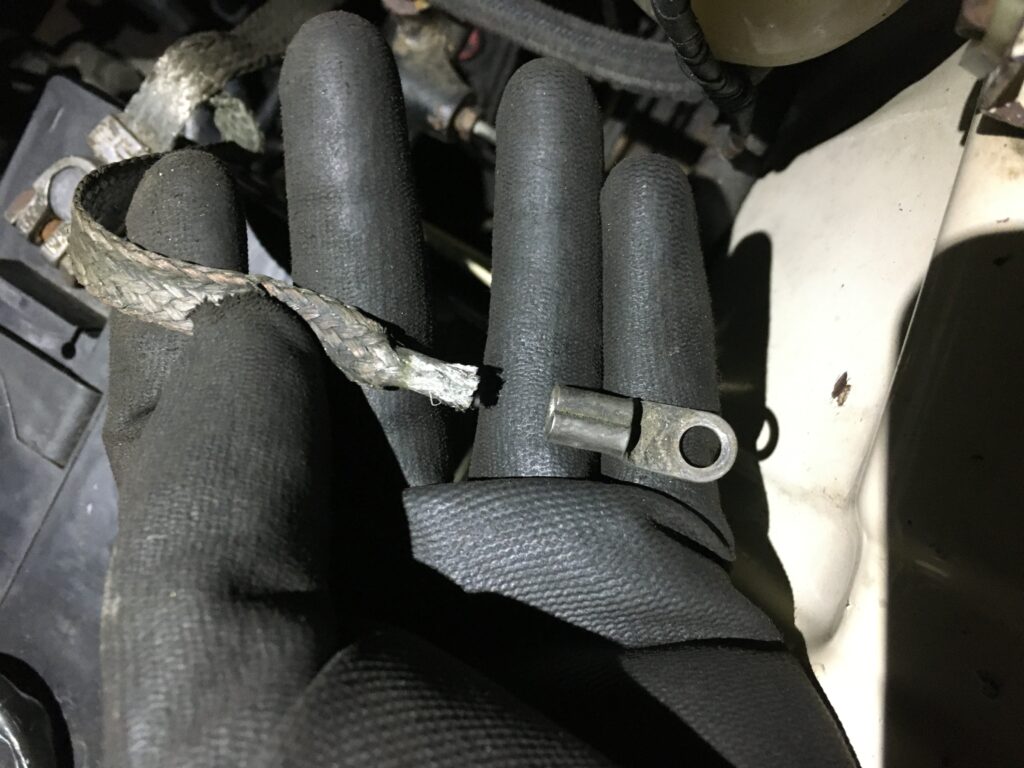
Whoops!
I didn’t have a heavy-duty crimping tool with me in Monson, however, so I wedged the end of the strap behind the eyelet. Hey, at least it was grounded instead of flapping in the breeze.

More than good enough for now.
Whether it simply was the priming from the electric fuel pump or whether the re-attached ground strap had anything to do with it, I don’t know, but Hampton started instantly. I pulled it out of its space in the Monson warehouse. In start contrast, when I went to pull Louie in, it wouldn’t restart until I connected the battery-to-coil jumper wire. So I’m putting a car into storage with a known problem that will certainly slap me in the face when I take it back out.

Louie goes back into storage for a spell.

Hampton enjoys seeing sunshine for the first time since May.
I drove home in Hampton in R75/3 mode—75 mph, two windows down, and the sunroof open. It was glorious.
As I got off the Mass Pike and drove on the local streets of my hometown of Newton (which, for an affluent leafy Boston suburb, has awful roads), I had an astonishing epiphany: Acceleration and handling notwithstanding, I was enjoying driving Hampton more than Louie. It was quieter. It felt more solid. I wasn’t thinking “Damn, I need to find and fix that.”
And that’s when it occurred to me—the two cars are entangled. They affect one other at a distance. Two roundie 2002s, sharing a set of seats. One suddenly becomes hard to start while the other one’s starting problem vanishes. Both got suspension upgrades. One becomes thunky and clunky enough that it’s no longer pleasant to drive on local roads while the other rides like a dream. Yup, quantum entanglement for sure.
Maybe it’s just the seats.
—Rob Siegel
____________________________________
Rob’s newest book, The Best of The Hack Mechanic, is available here on Amazon, as are his seven other books. Signed copies can be ordered directly from Rob here.

